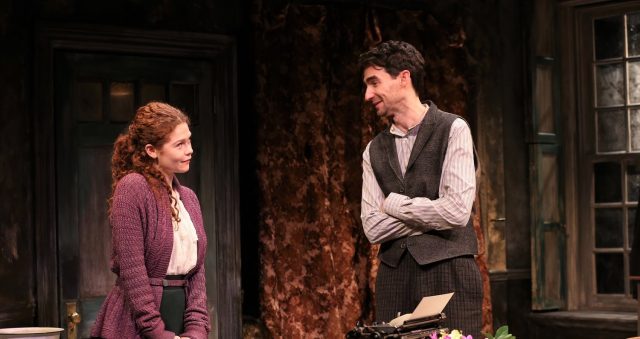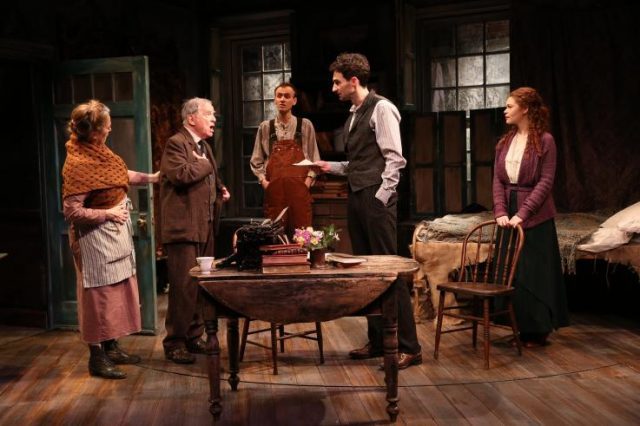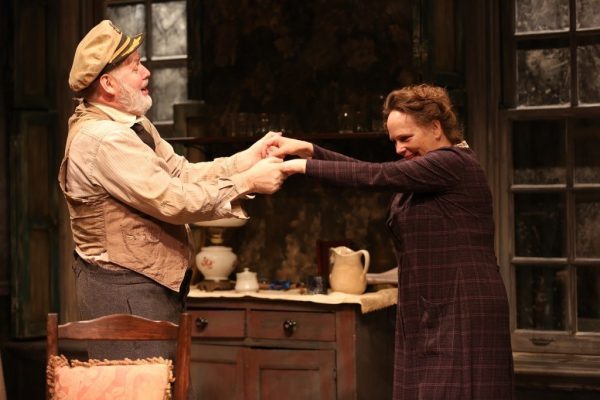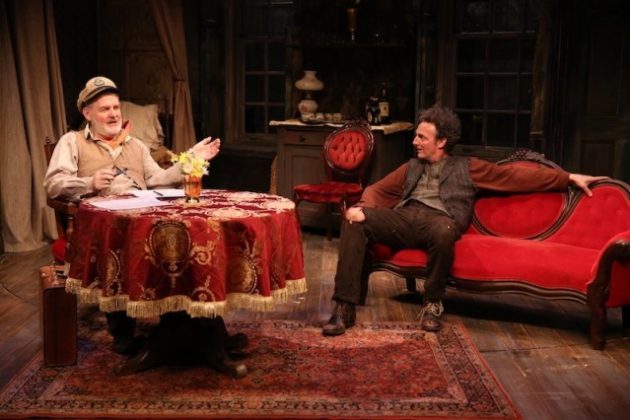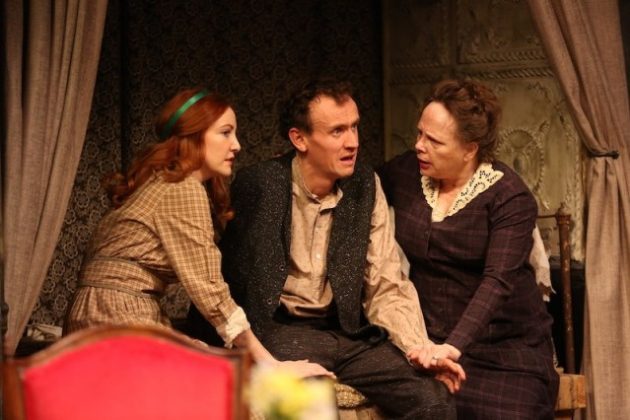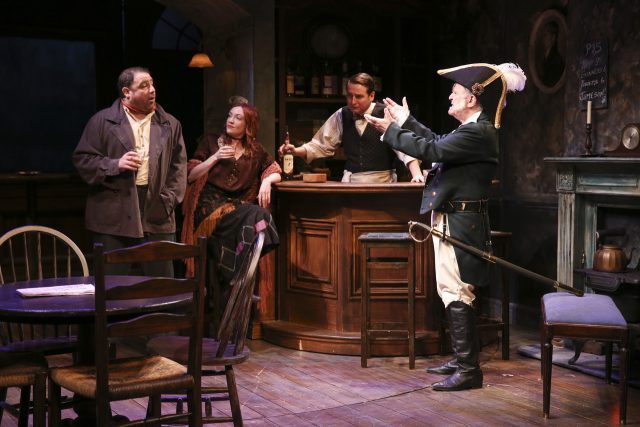
Irishman battles Irishman in Sean O’Casey’s The Plough and the Stars (photo by Carol Rosegg)
Irish Repertory Theatre, Francis J. Greenburger Mainstage
132 West 22nd St. between Sixth & Seventh Aves.
Through June 22, $50-$70
212-727-2737
irishrep.org
The Irish Rep concludes its outstanding “O’Casey Cycle” with the third play in Sean O’Casey’s Dublin Trilogy, The Plough and the Stars. The controversial 1926 work, the follow-up to 1923’s The Shadow of a Gunman and 1924’s Juno and the Paycock, the semiautobiographical The Plough and the Stars is the earliest of the stories, taking place in 1915-16 around the Easter Rising, when the Irish Volunteers and the Irish Citizen Army battled the British army and Dublin Fusiliers, Catholics against Protestants in a violent rebellion. Charlie Corcoran’s immersive set, which extends up the sides of the theater and down the hall, changes from a tenement apartment to a pub and the street outside as a close-knit collection of intriguing characters prepare for a fight.
The play begins in November 1915 in the living room of Jack Clitheroe (Adam Petherbridge), a bricklayer, and his wife, Nora (Clare O’Malley), an elegant woman who wants more out of life; he’s a bit disappointed as well, dismayed that he had been passed over for a promotion to captain in the ICA. Carpenter Fluther Good (Michael Mellamphy) is attempting to get rid of the squeak in the front door as nosy charwoman Mrs. Grogan (Úna Clancy) accepts a package for Nora and opens it to find a fancy hat. “Such notions of upper-osity she’s getting’,” she declares. “Oh, swank, what!” Nora comes home to find her uncle, the daffy Peter Flynn (Robert Langdon Lloyd), and Fluther having words with the Young Covey (James Russell), a wisecracking atheist and socialist who enjoys riling people with his progressive beliefs.

Nora (Clare O’Malley) begs her husband, Jack (Adam Petherbridge), not to join the fight in conclusion of Sean O’Casey’s Dublin Trilogy (photo by Carol Rosegg)
Fruit vendor and Protestant loyalist Bessie Burgess (Maryann Plunkett) stops by to heap disdain on Nora, calling her a “little over-dressed trollope.” After everyone else leaves, Capt. Brennan (John Keating) arrives to tell Jack that he is the new commander of the eighth battalion of the ICA and must lead a reconnaissance attack, which upsets Nora, who wants him to stay home with her. Jack storms out with Capt. Brennan, and a distraught Nora is then visited by Mollser (Meg Hennessy), Mrs. Gogan’s sickly fifteen-year-old daughter who dreams of having the life Nora does. “I often envy you, Mrs. Clitheroe, seein’ th’ health you have, an’ th’ lovely place you have here, an’ wondherin’ if I’ll ever be sthrong enough to be keepin’ a home together for a man,” Mollser says. As a regiment passes by on its way to the front, Bessie sticks her head in to condemn the soldiers. It’s a brilliant first act, firmly establishing the characters, mixing in humor with dread as darkness awaits. “Is there anybody goin’, Mrs. Clitheroe, with a titther o’ sense?” Mollser asks.
The next three acts build on that extensive framework, with the addition of prostitute Rosie Redmond (Sarah Street), a barman (Harry Smith), a woman from Rathmines (Terry Donnelly) who is terrified of what is going on outside, and Jack’s flag-waving compatriots Lt. Langon (Ed Malone) and Sgt. Tinley (Smith). Director Charlotte Moore, the cofounder of the Irish Rep with Ciarán O’Reilly, knows the play well; she previously helmed the company’s 1988 production, its first show ever, as well as its 1997 revival. In honor of the Irish Rep’s thirtieth anniversary season, O’Reilly again is the voice of the speaker, as he was in 1988, spouting rhetoric to the assembled masses based on the words of Irish activist Padraig Pearse. The cast, most of whom also appear in The Shadow of a Gunman and Juno and the Paycock, is exemplary, creating a wholly believable fictional world.
During the first week of the premiere of The Plough and the Stars at the Abbey Theatre in Dublin in 1926, there were protesters and demonstrators angry with O’Casey’s treatment of Irish nationalism and religion, leading to a riot in which actor Barry Fitzgerald punched out a man who had climbed onstage, knocking him into the orchestra pit. “You have disgraced yourselves again,” senator and Abbey director W. B. Yeats said to the crowd. “Is this going to be an ever-recurring celebration of the arrival of Irish genius?” The 2019 iteration of the play might not pack the same kind of wallop, but it is a potent portrayal of civil strife and the power religious and political disagreement has to tear apart friends and neighbors, something we know all too well given the current climate in America.
